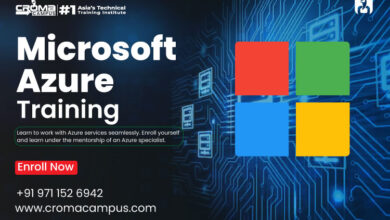Best Linux Training in Chandigarh

Best Linux Training in Chandigarh
In today’s technology-driven world, proficiency in operating systems is crucial for IT professionals. Among various operating systems, Linux has gained immense popularity due to its flexibility, security, and open-source nature. For individuals in Chandigarh aspiring to advance their careers in IT,
Linux training can be a transformative experience that equips them with the necessary skills to excel in various fields, including system administration, cloud computing, and software development.
This article aims to provide an overview of Linux, its components, usage, functionality, and the significance of Linux training in Chandigarh.
What is Linux?
Linux is an open-source operating system that serves as the foundation for numerous distributions, commonly referred to as “distros.” Developed by Linus Torvalds in 1991, Linux is based on the Unix operating system, providing a stable and powerful environment for users. Its open-source nature allows developers to modify, distribute, and customize the software, making it an appealing choice for individuals and organizations seeking a cost-effective and secure operating system.
Linux is widely used across various platforms, including personal computers, servers, mainframes, and embedded systems. Its versatility and robust performance make it a preferred choice for many enterprises and developers worldwide.
How is the Linux Operating System Used?
Linux is utilized in various domains due to its reliability and security features. Some common use cases include:
- Server Management: Linux dominates the server market, powering a significant percentage of web servers and cloud services. Its stability and ability to handle multiple tasks simultaneously make it ideal for hosting websites, applications, and databases.
- Development Environment: Developers favor Linux for programming due to its compatibility with multiple programming languages, frameworks, and tools. The command-line interface (CLI) allows for efficient coding and testing.
- Cloud Computing: Many cloud service providers utilize Linux-based operating systems to run their services, providing users with scalable and flexible solutions.
- Embedded Systems: Linux is widely used in embedded systems, powering devices such as routers, smart TVs, and IoT devices, thanks to its lightweight nature and adaptability.
- Networking: Linux provides powerful networking capabilities, making it suitable for creating and managing network servers and devices.
Linux Components and Terminology
Understanding Linux requires familiarity with its components and terminology. Here are some key components:
- Kernel: The kernel is the core component of the Linux operating system, managing hardware resources and facilitating communication between software and hardware. It is responsible for memory management, process scheduling, and system calls.
- Shell: The shell is a command-line interface that allows users to interact with the operating system. It interprets user commands and executes them, providing a way to control the system efficiently.
- File System: Linux uses a hierarchical file system that organizes files and directories. The root directory (“/”) is at the top, and all other directories branch out from it. Common directories include
/home(user files),/etc(configuration files), and/var(variable data). - Distribution: A Linux distribution, or distro, is a packaged version of the Linux operating system, bundled with the kernel, applications, and libraries. Popular distributions include Ubuntu, CentOS, Fedora, and Debian.
- Package Manager: Package managers are tools that simplify the installation, update, and removal of software on Linux. They handle dependencies and ensure that software is properly installed. Examples include APT for Debian-based systems and YUM for Red Hat-based systems.
How the Linux Operating System Works?
Linux operates based on a multi-user, multitasking architecture, allowing multiple users to access the system simultaneously. Here’s a brief overview of how it works:
- Boot Process: When a Linux system starts, the BIOS initializes hardware components and loads the bootloader, which in turn loads the Linux kernel into memory. The kernel then initializes system resources and starts the init process.
- User Interfaces: Users can interact with Linux through command-line interfaces (CLI) or graphical user interfaces (GUI), depending on the distribution and personal preference. The CLI offers more control and flexibility, while the GUI provides a more user-friendly experience.
- Processes and Scheduling: Linux manages multiple processes by allocating CPU time through scheduling algorithms. Each process runs in its own memory space, ensuring stability and security. The kernel handles the creation, execution, and termination of processes.
- File System Management: Linux maintains a structured file system, enabling users to navigate directories, create files, and manage permissions. The system provides commands for file manipulation, allowing users to perform tasks such as copying, moving, and deleting files.
- User Permissions: Linux employs a robust permission system that restricts access to files and directories. Each file has an owner and designated permissions (read, write, execute) for the owner, group, and others, ensuring security and privacy.
Conclusion
In conclusion, Linux is a powerful and versatile operating system widely used across various domains, from servers to embedded systems. Its open-source nature and extensive capabilities make it a preferred choice for many organizations and developers. For individuals in Chandigarh looking to enhance their IT skills, Linux training provides a comprehensive understanding of the operating system, its components, and practical applications.
By enrolling in Linux course in Chandigarh programs, aspiring IT professionals can gain valuable knowledge and hands-on experience, opening doors to career opportunities in system administration, cloud computing, and software development. As the demand for Linux expertise continues to grow, investing in Linux training is a strategic move for anyone looking to thrive in the ever-evolving tech landscape.





